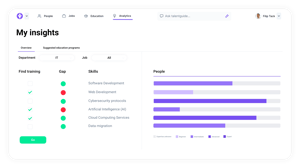The failure of competence thinking
On April 6, 2023, VDAB announced that despite a year of effort, four out of ten inactive individuals remained unplaced, prompting calls from both employer and employee representatives for VDAB to enhance their efforts. Unfortunately, as long as VDAB relies on competency-based thinking as the foundation of their services, they will fall short in their role.
Every week, there is news about labour market shortages, bottleneck economies, and the many challenges to achieving an employment rate of 80%. However, the remaining candidates in the labour market, such as inactive individuals, social welfare recipients, long-term sick, or long-term unemployed, pose a different set of challenges. While a range of tools such as workplace learning, training, mediation, and intensive services are used to promote activation, they do not always yield the desired results. Competency-based thinking has its limitations, and it is time to adopt a different approach to address these challenges.
Jobs as a set of competencies
The current VDAB instrumentarium is based on competency-based thinking, which describes a job as a set of competencies, each representing a skill and knowledge necessary to express that competency. However, there are two limitations to this approach. Firstly, competency-based thinking overestimates the similarities between candidates who possess the same competency within a job. For example, an engineering diploma does not indicate on a CV what differences there are per competency. Additionally, competency-based thinking underestimates the similarities between jobs that contain the same competencies. Secondly, it is mistakenly assumed that complete jobs would disappear due to digitisation and robotisation, while often it is only a part of jobs, a role, or an activity that has been digitised, such as self-scanning in supermarkets. Thus, the competency-based approach is too vague, hindering activation, especially for the renewed target group and labour market mobility more generally.
Jobs as a set of roles and activities
What if jobs were described as a set of roles? For instance, the bottleneck profession of an "Operator" can be divided into roles such as preparing the work, maintaining, analysing, and reading data. An allocation of possible roles makes it possible to recombine those roles into two new jobs, making them more accessible for a new target group or enabling internal job mobility.
If those roles were further divided into activities to be carried out, it could broaden the internal labour market within companies and across companies and sectors. For example, weighing quantities is a task that can be found in many different professions in both the food and chemical industries. Decontextualising activities expands the scope of the labour market.
HR frontrunners do not wait for the government to get creative in times of labour market shortages. We already see examples of job redesign or duplication in a set of roles that together made up a former job. In addition, there is a greater emphasis on a more detailed level when recruiting candidates. In the textile industry, hairdressers are recruited for their fine motor skills.
This is where talentguide comes in, offering an advanced database of skills and activities linked to functions, employees, and training within your company, and benchmarked against evolving industry standards. talentguide bridges the competency-based thinking gap and focuses on maximum employability. It replaces the competences framework with a roles and tasks framework that is more fine-grained, thus helping to overcome the challenges of labour market activation.





